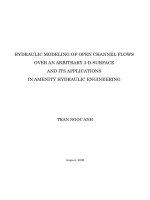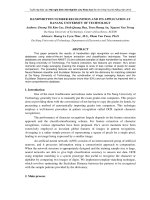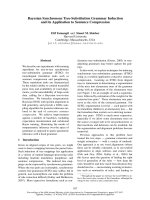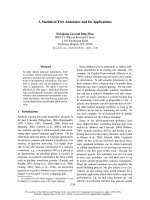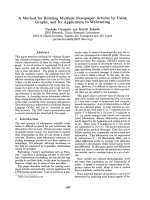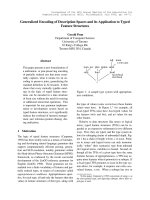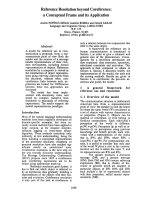Integral and its application
Bạn đang xem bản rút gọn của tài liệu. Xem và tải ngay bản đầy đủ của tài liệu tại đây (3.02 MB, 33 trang )
Group 3
Group 3
Group 3
Mathematical Analysis I
Quỳnh Anh
Dũng
Hồng Mai
Quỳnh 16
Thảo
Mạnh
Vũ
Ngọc
Group 3
MATHEMATICAL ANALYSIS I
Integral and its application
About the introduction
The overview about
and development of the
antiderivative
theory of integration
- integrals
Content 1
Ghi chú Nội dung 1
Content 2
Content 3
Content 4
Application of definite
Conclusion and
integrals
references
Group 3
MATHEMATICAL ANALYSIS I
Integral and its application
Content 1
The overview about antiderivative - integral
1.Antiderivative indefinite integral
Content 2
Ghi chú Nội dung 2
Content 3
Content 4
2. Definite integral
3. Integration method
Group 3
MATHEMATICAL ANALYSIS I
Integral and its application
Content 1
Ghi chú Nội dung 1
Content 2
Some details on the birth and development of integral
theory
1. History of integrals
2. A brief overview of the
application of integrals.
Content 3
Ghi chú Nội dung 3
Content 4
Group 3
MATHEMATICAL ANALYSIS I
Integral and its application
Content 1
Ghi chú Nội dung 1
definite integrals
Content 2
Ghi chú Nội dung 2
2.Algebraic application of definite
integrals
Content 3
Application of
definite integrals
Ghi chú Nội dung 4
Content 4
1.Geometrical applications of
Group Name
MATHEMATICAL ANALYSIS I
Integral and its application
Content 1
Ghi chú Nội dung 1
Content 2
Ghi chú Nội dung 2
Conclusion
Content 3
Ghi chú Nội dung 3
Content 4
Conclusion
1
CONTENT 1
The overview about antiderivative
- integrals
1.
-
CONTENT 1
Primitive - indefinite integral.
A.
Definition
i.
Antiderivative
The function F(x) is an antiderivative of the function f(x) on (a, b) if F'(x) = f(x) ∀x ∈ (a, b).
F(x) = G(x) + C
ii.
Indefinite integral
The set of antiderivatives of f (x), recorded as ∫f(x)dx is called the indefinite integral of the
function f(x).
-
Properties
1) [ f(x)dx]’ = f(x)
∫
Let F(x) and G(x) be two antiderivatives of the function f(x) on (a, b), then there exists a
constant C such that:
-
B.
If F (x) is an antiderivative of f (x) then we have
∫
�(�)�� = F(x) + C (C =
const)
2) [f(x) ± g(x)]dx = f(x)dx ± g(x)dx
∫
∫
∫
3) kf(x)dx = k f(x)dx (với k ∈ R)
∫
∫
CONTENT 1
2.
Definite integral.
B.
A.
Properties
Definition
. Consider the function f(x) on a closed interval [a,b] and divide [a,b] into n points:
1.a= x-0
f(x) ≥the
0, Riemann
x [a,b], then
sum:
3.Sn==If f(x)
g(x),
(xi–x≥i-1
).f(ɛxi) =[a,b],
(x1–xthen
0).f(ɛ1) + (x2–x1).f(ɛ2) +…+ (xn–xn-1).f(ɛn)
4. |
If max |x − x | → 0, then Sn → α, that means f(x) is an integrable function
5. = + (ai b c)i–1
�
�
∫
1≤i≤n
�
�(�)�� = F(b) – F(a) ≡ [�(�)]|
and α is called integral of f(x) on [a,b], or = α
. If a function f(x) is continuous on [a,b], then f(x) is integrable on [a,b]
. Instead of the above definition, we can also define an integral by Newton – Leibnitz formula:
�
CONTENT 1
3.
Integration method
A.
The antiderivative of a basic function
ii.i.
iii.
special
Elementary
function function
Inverse
trigonometric
Common
functions
1)
1)
2)
2)
2) ) ϵ (
3)
3) ) ϵ [
4)
4) ) ϵ [
3)
4)
1) ) ϵ (
5)
6)
7)
8)
5)
9)
6)
CONTENT 1
3.
Integration method
B.
C.
Methods
of integral calculation
Sub-conclusion
Example 1:
So
From this we see that in addition to applying basic trigonometric transformations, the recognition of “hidden” trigonometric differential formulas will also
Solution:
- As learned in high school, to determine an integral expression we usually use two methods: By substitution and by parts. Use the above two methods,
be an important skill. If I realise them, the problem solving becomes much simpler.
set
I=combining
other mathematical tricks, we can easily solve all the fundamental integrals. Moreover, in some definite integral problems, based on the two
: some of the following common types:
Like
limits
of the integral we can find the way to solve the problem.
1) (Acosx ∓ Bsinx)dx = d(Asinx ± Bcosx + C)
2
2
2) (A ∓ B)sin2xdx = d(Asin x ± Bcos x + C)
4
4
3) −sin4xdx = d(sin x + cos x + C)
NỘI DUNG 1
Content 2
Some details on the introduction and development of
When was integral
integrals
introduced? How does
it develop?
What is the application of
integrals in the development
of the history of science?
1. History of
2. A brief overview of
integrals
the application of
integrals.
NỘI DUNG 1
Content 2
1.
2.
History
intergrals
Integralofapplication
the force used on the ship; or it is still not possible to calculate the appropriate angle of fire
But it's interesting that the first person to fly into space is Yuri Gagarin
Newton and Gottfried Leibniz abstracted the above connection into
(1934 - 1968) – a Soviet pilot and cosmonaut. His space trip lasted 108
the connection between differential and integral, two important
minutes on April 12, 1964 and became an important event in human’s
shapes of calculus.
history.
Newton and Leibnitz, together with their students, used the
in the
with
resistance
the bullet to go the farthest. Today, the infinitesimal
who
laidenvironment
the first brick to
enable
integralfor
math.
relationship between differential and integral to broaden methods of
Until
the 17th
the systematic
of the above
of area
andIn volume
calculus
is onecentury,
of the important
toolsdevelopment
in physics, economics
and method
probability
theory.
the
integration, but methods of integral calculation are known in the
calculation was done by mathematicians such as Cavalieri, Torricelli, Fermat, Pascal and many other
equation. The present degree is largely presented in Euler's work. The
mathematicians. In 1659, Barrow established the relationship between the area calculation and the
contributions of mathematicians Tchébicheff and Ostro-gradski ended
tangent finding of the relevant curve. Not long after, Issac
the process of developing this calculation.
Calculating the area of a plane or calculating the volume of an object in space, whose shape could not
Before the advent of integrals, mathematicians were able to calculate the speed of a
apply the formulas of elementary geometry had long been devised. Since ancient times, the eminent
ship. But they still could not calculate the relation between the acceleration and the ratio of
mathematician and physicist Archimède has used elementary mathematical tools to calculate the area
of a number of planes limited by curves such as spheres and cones. He is considered to be the person
1960s, the first infinitesimal functions had helped aerospace engineers in project Apollo to
calculate the data that landed the first human – Neil Armstrong on the Moon.
Content 3
I.
DUNG 1
Application ofNỘIdefinite
integrals
Geometrical applications of definite integrals
1.
A.
General diagram using integral
The first method – sum of integrals
Integral value:18.92
Integral value:18.92
Total area: 10 trapezoids
Total area: 20 trapezoids
We want to calculate any quantity Q such as volume, area, length, etc. We divide Q into n parts in an appropriate way:
Q = Q1 + Q2 +…+Qn
(1)
Then calculate the approximate value of Q k, plug in (1) and use the limit to find the sum Q.
- We used the above method to calculate the area under a curve and got:
- The larger n is (the greater the number of division), the higher the accuracy, so the calculation is very hard. The integral helps
us to reduceIntegral
the error
and calculate the exact value of the quantity we are looking for. Integral value:18.92
value:18.92
Total area: 50 trapezoids
Integral value:18.92
Total area: 100 trapezoids
by:
x-axis,
y = f(x) = cosx + 2 and
two lines x = 0; x = 9.5.
(we will learn more in part 3.1.2)
Total area: 30 trapezoids
Ex : Find the the area of the plane bounded
1
NỘI DUNG 1
Content 3
1.
General diagram using integral
B.
Secondmethod–differentialdiagram
-Assumpti
on:Quanti
<�<�′
≤�
∆Q=q(x)∆x
+0(∆x)tyQdependson
(2)thesegments: �≤�′
W=>
ehave:Q[a',b']=Q[a',c]+Q[c,dQ(x)
b'] =q(x)dx,so:
and
=Q[a,
=Q[a,
b]b]
= (3)
To-calculateQwesetQ(x)=Q[a,Sox].the
Consi
deringofinthe
crements:
content
differentialdiagrammethodistoestablishtherelation(2),whosefinalresultis
(3).=Q(x+∆x)−Q(x)=Q[a,x+∆x]−Q[a,x]=Q[x,x+∆x]
∆Q
Andtrytorepresentitaslinearintermsof∆x:
2.Area of flat figure
NỘI DUNG 1
Content 3
A. Area under the curves in Cartesian coordinates
Apply the sum of integrals method to calculate the area of
the plane figure S formed by two any functions f 1(x) and f2(x) that
y
can be divided into an infinite number of curved trapeziums MPFE y+∆y
P
y
(Figure 1). It is easy to prove the following cases:
M
F
E
a
O
If the function y = f(x) is continuous on [a, b] then the area S under:
x
x +∆x
b
x
y
(C): y = f(x)
+∆x
a
O
b
x
NỘI DUNG 1
Content 3
Example 2: Calculate the area S under the curves:
We have:
S=
S=
=
=.
Content 3
If two functions y = f(x) and y = g(x) are continuous
on [a, b] then the area S under the curves:
NỘI DUNG 1
Content 3
NỘI DUNG 1
Note: Four lines of the graph formed by two continuous functions f(x) and g(x) and two lines
�= �; = b always create a plane. However, just two graph of two continuous functions f(x) and
g(x) are enough to form a plane figure, for example as shown in the following figure:
Problem: Find the area of a plane figure S bounded by are two open curves and intersect to each other.
+ Step 1: Solve the equation
+ Step 2: Use the formula:
NỘI DUNG 1
Content 3
Example 3: Calculate the area under the curves:
We consider the difference of two functions:
Note: Equation (4) is only used to calculate the area of a limited simple plane (H) by the graph of the function f(x), g(x) and two lines x = a, x = b.In the case of
Because at 3 points whose coordinates are -2;0;1. So the area of the figure is:
a plane figure (H) is defined by more than two graphs of the function, then to calculate the area (H), we must draw figure (H) – ie draw defined lines (H).
Based on that, we divide the plane figure (H) into simple shapes simple that we know how to calculate.
Content 3
Example 4: Calculate the area S of the plane figure (H) under by the graph of the function
and straight line
Equation of the intersection point:
1,
2,
3,
We can easily see the area of the plane figure (H):
(H) =
=
NỘI DUNG 1
Content 3
2.
NỘI DUNG 1
Area of a plane bounded by a line with parametric equations
If the curve (C): y = f(x) has parametric equation
Example 5 : Calculate the area of an ellipse formed by (E)
In the formula to calculate the area I replace
We
have the parametric equation of (E) on the first quadrant on the plane (Oxy).
+ y = f(x) by y = ω(t)
′
+ dx by φ (t)dt
+ Two limits a and b are replaced by α and β which are solutions of a = φ(α) and b = φ(β) respectively.
Then :
S=
Converting the integral we get:
If the curve (C) is closed, counter-clockwise and the area S is limited to the left and (C) has a
parametric equation with 0 ≤ t ≤ T where T
is the period of it.
So
